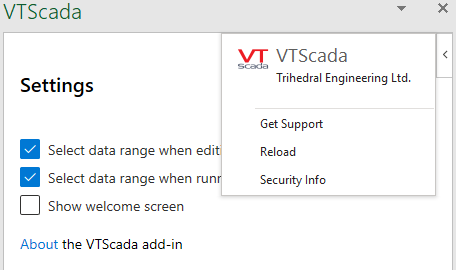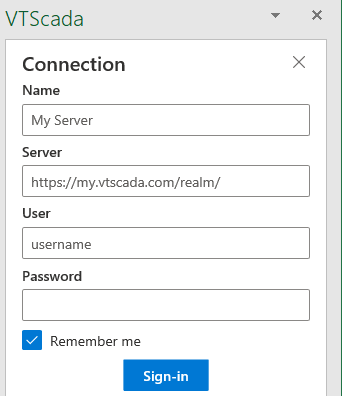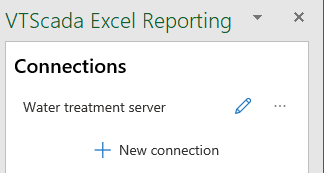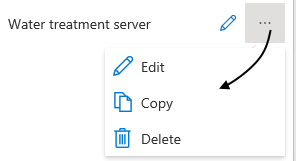Create and Manage Connections
The use of a secured connection (X.509 certificate) is mandatory. The VTScada Excel add-in will not connect to an unsecured server.
You can use a self-signed certificate, provided that you add a local loop-back exemption if both Excel and VTScada are running on the same workstation. Refer to Microsoft's trouble-shooting instructions. (Link opens in a new tab or window.)
The instructions for creating a self-signed certificate are well outside the scope of this documentation. There are many references available on the Internet, as well as many guides to the risks and benefits. Ensure that you take all necessary security precautions.
The Excel Add-in does not support connection through OpenID Connect. Ensure that the setting "Permit remote sign-in using VTScada account credentials" in the application's Security options is enabled.
The connection uses the VTScada Internet Server. Follow the instructions within Configure a VTScada Thin Client Server and Configure a Realm.
Your VTScada license must include the Remote Data Access feature.
For greater security, consider using one or more of the SQL View Tag, each of which can be assigned a custom privilege.
The Remote Tag Value / History Retrieve privilege is necessary in order to run custom SQL queries. Accounts with only the Remote Data Access privilege can see only their assigned SQL views or AlarmHistory, and cannot run their own SQL queries or browse the tag parameter tables.
The add-in will work best with the 1.4 version or later of the Excel API. It is compatible with the 1.1 API version, but may not perform as well.
In terms of Excel version, the add-in is compatible with Office 2016 build 16.0.4390.1000 or later and any version of Office Online.
An uncommon configuration requirement is to allow for Domain Aliases (CORS).
When each tool of the VTScada Add-in is opened, there will be a fly-out menu at the upper right. Use this to learn more about the tool.

Connections are saved in the current workbook. Note that the History panel will guide you through the creation of your first connection. You need only use the Manage Connections panel if you intend to set up multiple connections, edit, or delete an existing connection.
The procedure to create your first connection is the same whether you do so using the Manage Connections panel or the History panel.
You must connect to your VTScada server and sign in before creating or running queries. To do so:
- Open the VTScada toolbar in Excel and select either the Manage Connections tool or the History tool.
- The Connections panel will open beside your worksheet.
If you have not already created a connection in this workbook the Connection sub-panel opens automatically when you select the History tool. Otherwise, select New Connection.

The Connection panel.
Note the X in the upper right corner, which will close this sub-panel.
- Provide the following information:
- A name for the connection.
Any name may be used, but it may be helpful to create a connection name that matches the server name.- The URL for the server. This will typically include the realm name, where the application can be found.
This must use a secured connection. If you are using the standard port of 443, it need not be specified.- An account name for the VTScada application.
The account must have the Remote Data Access privilege.- The password for that account.
- Choose whether or not to remember the user name and password.
- Select Sign-in .
If successful(*), the connection name will be listed in the Connections panel. If you began the process by selecting the History tool, the Tag History Query panel will open immediately.

The Connections panel is available only after successfully creating a connection.
Use the Manage Connections tool to open.
Select the editing tool  to change the name, change the server address or to sign-out.
to change the name, change the server address or to sign-out.
Within the expandable menu, you can also edit, as well as copy or delete the saved connection.

You may choose to create additional connections for any of the following reasons:
- You have more than one server.
- You connect to more than one realm.
- You have more than one application.
(*)Troubleshooting
An attempt to connect might fail for any of the following reasons:
A bad server address
Make sure the address can be reached from the local computer. If the address works for the VIC or Anywhere Client, it should work for the add-in.
Unsecured server
Make sure that the server is secured with a certificate.
Wrong or missing realm name
Provide the necessary realm as part of the server address.
The application is not running on the VTScada server.
Ensure that the application is running.
The VTScada server does not support the Excel add-in
Ensure that the server is running VTScada version 12.0 or later.
The VTScada server is not licensed to allow remote data retrievals
Purchase the required option for your VTScada license.
